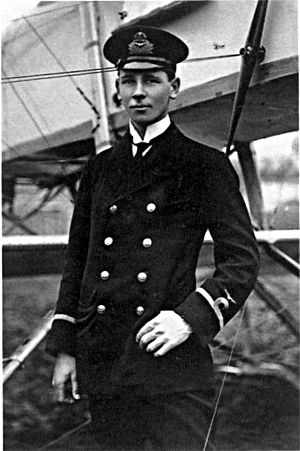Reginald Warneford facts for kids
Quick facts for kids
Reginald Warneford
|
|
|---|---|

Warneford standing in front of a Maurice Farman Shorthorn
|
|
| Born | 15 October 1891 Darjeeling, British Raj |
| Died | 17 June 1915 (aged 23) Buc, Yvelines, France |
| Buried |
Brompton Cemetery, London
|
| Allegiance | United Kingdom |
| Service/ |
Royal Navy |
| Years of service | 1914–1915 |
| Rank | Sub-Lieutenant |
| Unit | No. 1 Squadron RNAS |
| Battles/wars | First World War |
| Awards | Victoria Cross Legion of Honour (France) |
Reginald Alexander John Warneford (born October 15, 1891 – died June 17, 1915) was a brave British pilot. He was also known as Rex Warneford. He served in the Royal Naval Air Service during the First World War. He earned the Victoria Cross, which is a very high award for bravery. He received it for successfully bombing a German airship called a Zeppelin. This was the first time an airplane had ever defeated a lighter-than-air airship in battle.
Contents
Early Life and Joining Up
Reginald Warneford was born in Darjeeling, India, on October 15, 1891. His father was an engineer working on the Indian Railways. Reginald moved to England as a young boy. He went to school at King Edward VI School, Stratford-upon-Avon. Later, his family returned to India, and he continued his studies there.
After finishing school, he worked in the Merchant Marine. He then joined the British-India Steam Navigation Company. When the First World War began, he was in Canada. He quickly sailed back to Britain. He first joined the army, but soon transferred to the Royal Naval Air Service. This is where he began his pilot training.
Becoming a Pilot
Warneford started his pilot training at Hendon, England. He then moved to Upavon in Wiltshire. He finished his training and became a pilot on February 25, 1915.
His flying instructor, Warren Merriam, saw that Warneford was a very skilled pilot. However, some thought he was too confident and lacked discipline. Merriam arranged for Warneford to show his flying skills to a senior officer. This helped Warneford get his officer's rank.
Daring Missions
Warneford was first sent to a unit on the Isle of Sheppey. Soon after, on May 7, 1915, he moved to a combat unit in Veurne, on the Belgian coast. Over the next few weeks, he flew many missions. He attacked German troops and guns. He also fought against enemy aircraft.
Because he was so aggressive and effective, he was given his own aircraft. He also received a special "roving commission." This meant he could fly missions more freely.
On May 17, 1915, Warneford met a German Zeppelin airship, LZ 39. This Zeppelin was heading to attack the UK. Warneford attacked it with his machine gun. But the airship was able to fly higher and get out of his range.
Destroying a Zeppelin
On June 7, 1915, Warneford was flying a Morane-Saulnier Type L airplane near Ghent, Belgium. He spotted another German Army airship, LZ 37. He chased the airship from the coast near Ostend. The Zeppelin fired back at him with its machine guns.
Despite the danger, Warneford managed to drop his six bombs on the airship. The last bomb hit its target and set the Zeppelin on fire! LZ 37 then crashed in Sint-Amandsberg, a part of Ghent. It crashed into a school building, sadly causing some deaths on the ground. The commander of LZ 37 and seven of its crew members were killed.
The explosion from the Zeppelin flipped Warneford's plane upside down. It also stopped his engine. He had no choice but to land his plane behind enemy lines. He spent about 35 minutes fixing his engine. Just as German soldiers realized what was happening, he managed to restart it. He famously yelled, "Give my regards to the Kaiser!" before taking off again. He then flew safely back to his base.
A Hero's End
On June 17, 1915, Warneford received a special award. It was the Légion d'honneur from the French Army Commander in Chief, General Joffre. This was a great honor.
After a celebration lunch, Warneford went to an airfield in Buc, France. He was supposed to fly an aircraft to his unit. He made one short test flight. Then, he took off for a second flight with an American journalist, Henry Beach Needham, as his passenger.
As the plane climbed to about 200 feet, the right wing suddenly broke off. This caused the plane to crash. Reports suggest that neither Warneford nor his passenger were strapped in. They were both thrown from the aircraft and suffered fatal injuries. The journalist died instantly. Warneford died from his injuries on the way to the hospital.
Reginald Warneford was buried at Brompton Cemetery, London, on June 21, 1915. Thousands of people attended his funeral to honor him. His grave is located in front of the eastern colonnade.
Legacy
Reginald Warneford's Victoria Cross medal is now on display. You can see it at the Fleet Air Arm Museum in Yeovil, England. A street in Ghent, Belgium, was named Reginald Warnefordstreet. It is located exactly where the Zeppelin LZ 37 crashed. In 2016, a road in Salisbury, England, was also named in his memory: Warneford Crescent.
A composer named Howard Ellis Carr even wrote music about Warneford. It was part of his Three Heroes suite. This music included sounds that made you think of a Zeppelin air raid. The music became popular after the war. It was performed many times, including at The Proms concerts.
See also
- John Cyril Porte – A Squadron Commander who worked at Hendon Aerodrome.
- Leefe Robinson – Another pilot who received the Victoria Cross for shooting down a German airship.


